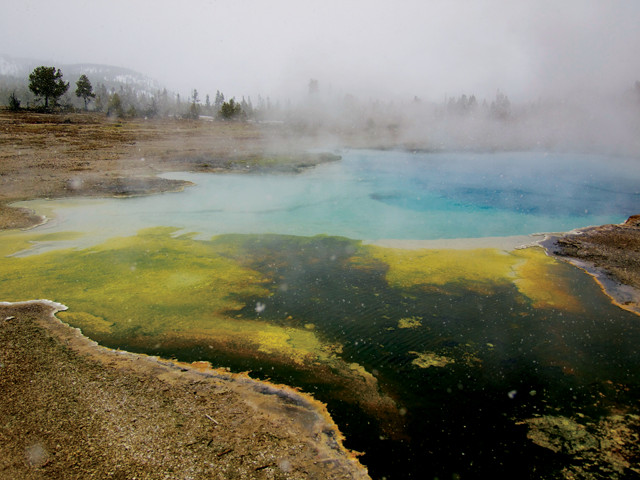
by Mary Caperton Morton Monday, February 29, 2016

Steam rises from a geothermal pool in Yellowstone National Park. The Yellowstone Supervolcano has erupted three times over the last 2 million years; it's still considered active, but it's not predicted to erupt again anytime soon. Credit: Mary Caperton Morton
If a supervolcano were to erupt today, its impacts could be catastrophic. Fortunately, no such eruption has occurred during human history. The lack of eyewitness accounts, however, makes it difficult for scientists to understand how supervolcanoes evolve and erupt. Based on a recent modeling study, researchers have offered a new hypothesis for how supervolcano eruptions might be triggered by external, rather than internal, forces.
To be classified as a supervolcano — such as Yellowstone Caldera in Wyoming or Long Valley Caldera in California — a volcano must have produced an eruption spewing more than 500 cubic kilometers of magma, greater than 500 times the volume of material ejected during the 1980 Mount St. Helens eruption.
Supervolcanoes don’t just differ from regular volcanoes in size, they also operate under different mechanisms, says Patricia Gregg, a volcanologist at the University of Illinois at Urbana-Champaign and lead author of the new study, published in the Journal of Volcanology and Geothermal Research.
“Regular volcanoes are typically triggered internally when pressure in the magma chamber increases until it can’t be contained,” Gregg says. “But these really large systems generate so much heat that rock around the magma chamber becomes ductile and flexible, which enables the chamber to accommodate even large changes in pressure” without erupting, she says.
Pressure is still thought to play a role, but whether the source is internal or external is a matter of debate. “Finding the source of pressure that triggers such massive eruptions has been the really hot topic recently,” says Wim Degruyter, a volcanologist at the Swiss Federal Institute of Technology in Zurich, Switzerland, who was not involved in the new study.
Two studies published in Nature in 2014 proposed that supervolcanoes could be triggered internally by pressure created by buoyant magma inside the chamber: As hot, less-dense magma rises in the chamber, it pushes against the roof of the magma chamber, supplying the internal pressure needed to trigger an eruption.
“In these systems, buoyancy is always present because of the density difference between the hot liquid in the magma chamber and the surrounding crust,” Degruyter says. When it was proposed in 2014, the magma buoyancy hypothesis “made a big impact,” he says, but the new study “completely disagrees with the buoyancy hypothesis.”
To study internal and external factors that might trigger supervolcano eruptions, Gregg developed a numerical model that incorporates physical parameters such as conservation of mass, energy and momentum to simulate what happens to the rock surrounding the magma chamber just before an eruption. She found that even with a very large density difference between the magma and surrounding rock, magma buoyancy added very little internal pressure to the system, making it an unlikely catalyst for an eruption.
Instead, she found that as the magma chamber expands, the roof grows more unstable due to extensional faulting in the rock. According to her models, if a crack or fault in the roof penetrates the magma chamber, magma may shoot to the surface through the opening, potentially triggering a chain reaction that could lead to an eruption.
The new model takes into account more parameters than the previously published magma buoyancy models, Degruyter says. “This is a very nice model that focuses on one particular aspect of eruptions: how the rock surrounding the chamber responds to stress. It doesn’t take into account what’s happening inside the magma chamber, or how other factors, such as bubble exsolution, might play a role in triggering eruptions.”
Degruyter says the simplification is necessary to make the model manageable for computation. “The problem with models is that they become very complicated really fast.” However, ever-improving computational capabilities mean that scientists should keep pushing toward creating more realistic models, he says.
Gregg and colleagues plan to do just that by using the Blue Waters Supercomputer at the National Center for Supercomputing Applications at the University of Illinois to run four-dimensional models tracking the evolution of the Long Valley Caldera magma chamber over time.
“We’re hoping to tease out what the precursors of super-eruptions look like, in hopes of pinpointing the potential triggers,” Gregg says. “Whether supervolcano eruptions are triggered by internal factors or by external forces such as faulting of the magma chamber roof — or even earthquakes — may mean that we should change how we monitor these volcanoes.”
© 2008-2021. All rights reserved. Any copying, redistribution or retransmission of any of the contents of this service without the expressed written permission of the American Geosciences Institute is expressly prohibited. Click here for all copyright requests.